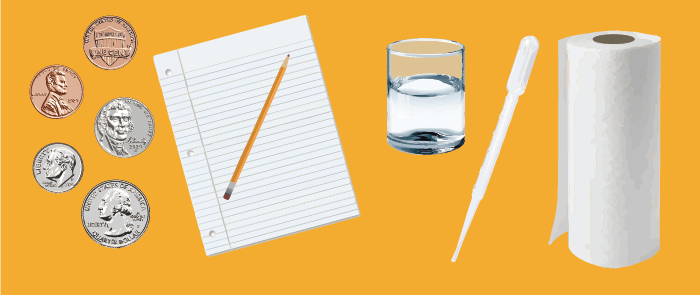
Have you ever noticed that when it rains, water forms as droplets on surfaces instead of spreading out? This is because of surface tension. See water surface tension in action using coins!
Grades: 2nd and up
Time: 20 minutes
Materials: different types of coins, paper towels, pipette or eye dropper, cup of water, pencil and paper, soap (optional), spoon (optional)
Steps:
- Collect different types of coins.
- Place each coin on a paper towel. Your goal is to see how many drops of water a coin can hold.
- Guess which coin will hold the greatest number of drops. Write down your guess on a piece of paper.
- Gather a pipette or eyedropper and a cup of water. Fill the pipette with water. Using the pipette, squeeze out the water, one drop at a time, onto the surface of a coin.
- Continue to add drops of water onto the coin. Notice how the water starts as a tiny droplet and gets bigger as more drops are added. Eventually, it forms a dome.
- Count the total number of drops on the coin until the water spills over. Write down the total number of drops for each coin.
- Repeat the process for each coin.
- Check your predictions:
- Was your guess correct?
- Which coin held the highest number of drops?
- Which coin held the least?
- Why do you think this is the case?
- Why didn’t the water spread out and flow over the edges of the coin? Water is made up of tiny molecules that are attracted to each other and stick together.
- The molecules at the surface are pulled inward by the molecules below it, which forms the dome shape. So, the surface molecules hold the droplet of water together. This is called surface tension. The higher the surface tension of the liquid, the bigger the droplet that forms.
For additional fun, try these variations of this activity.
- Add soap to the water and repeat the experiment. What happens when soap is added? Does adding soap increase or decrease the surface tension?
- Find out which side of a coin holds more drops. Pick one coin and make a prediction: will the obverse (heads) side or the reverse (tails) side hold more water? Then repeat Steps 4-6 above. Was your prediction correct? Why do you think one side of the coin holds more water than the other?
